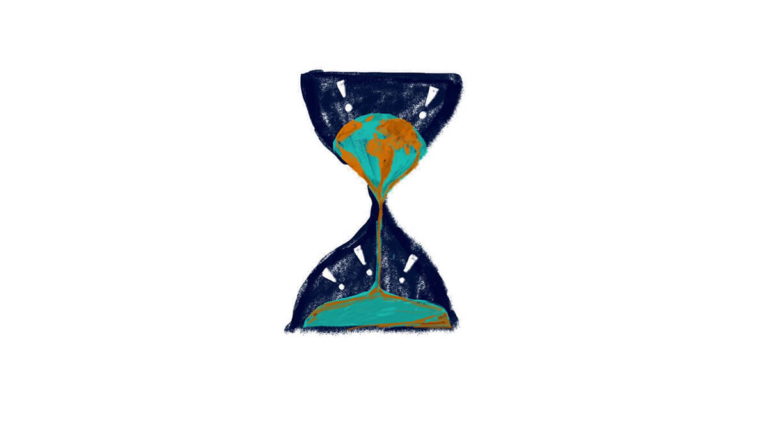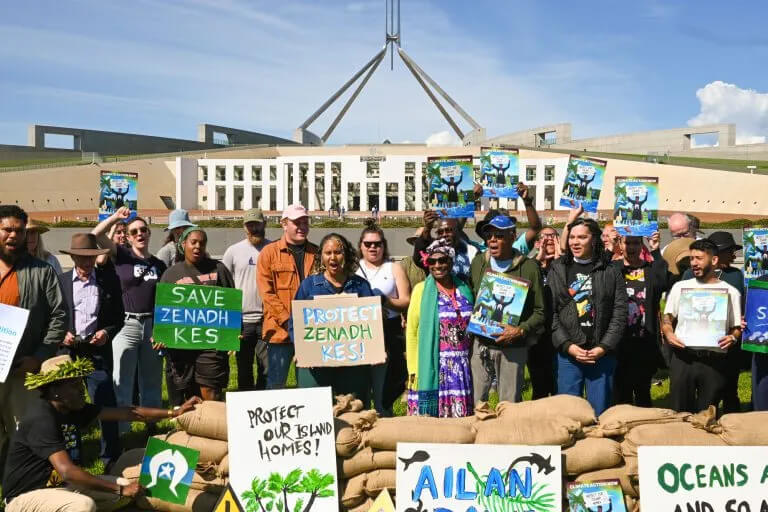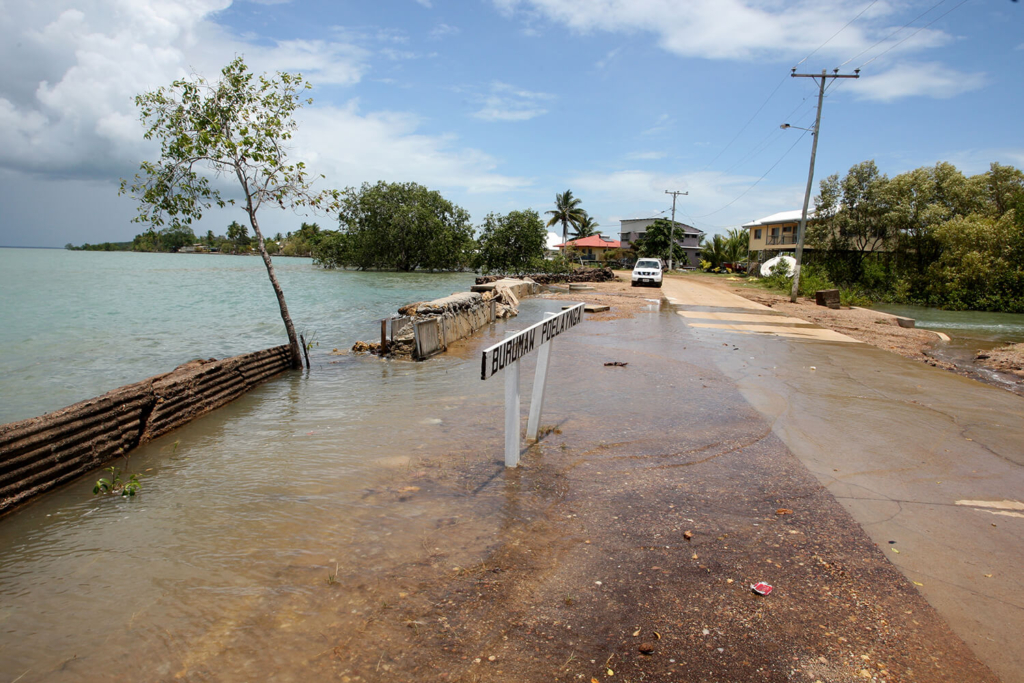Casebook Info
- Year Filed 2019
- Year of Most Recent Ruling 2022
- Year of Final Ruling 2022
- Jurisdiction International
- Court Name United Nations Human Rights Committee (UN HRC)
- Primary Focus Mitigation & adaptation
- Ruling On Merits
- Plaintiff(s) Eight Torres Strait Region Islanders & six of their children
- Respondent(s) Australia
- Outcome Ruling for the plaintiffs
- Organizational leader of the litigation ClientEarth; Gur A Baradharaw Kod (The Torres Strait’s leading land and sea council that represents the region’s traditional owners)
- Link to the decision/ruling
Background
On September 22, 2022, just one day before climate protests took place in around 450 places all over the world, the UN Human Rights Committee (Committee) published its landmark decision in the case Daniel Billy v. Australia. The Committee found that Australia failed to adequately protect members of an Indigenous community present in four small, low-lying islands in the Torres Strait region from adverse impacts of climate change, which resulted in the violation of the petitioners’ rights to enjoy their culture (Art. 27 of the ICPPR) and to be free from arbitrary interferences with their private life, family and home (Art. 17 of the ICCPR).
Daniel Billy v. Australia was not the first case related to human rights and climate change to be brought before either an international human rights monitoring body or the Committee itself. It was, however, the first of these cases to trigger a decision on the merits and result in a declaration of a violation of human rights norms. (In Ioane Teitiota vs. New Zealand, the Committee found no violation of the right to life (Art. 6 ICCPR) because there was still time for adaptation measures, while the Committee on the Rights of the Child declared the complaints in Sacchi v. Argentina inadmissible due to the petitioners’ failure to exhaust domestic remedies.)
What makes Daniel Billy v. Australia special is that it’s the first legal action brought by inhabitants of low-lying islands, which are particularly vulnerable to present and future negative impacts emanating from climate change, against a nation state.
Eight islanders from four Torres Strait islands belonging to the State of Queensland, Australia – Yessie Mosby and Nazareth Warria of Masig (Yorke Island); Keith Pabai and Stanley Marama of Boigu; Nazareth Fauid of Poruma (Coconut Island); Ted Billy, Daniel Billy, and Kabay Tamu of Warraber (Sue Island) – and six of their children claimed the infringement of their rights based on Australia’s twofold failure to maintain its obligations in light of sea level rise and extreme weather events. First, it failed “to implement an adaptation programme to ensure the long-term habitability of the islands,” and, second, it failed “to mitigate the impact of climate change” (¶¶2.7 and 2.8). Their complaint builds on the specific situation faced by the Indigenous community in the Torres Strait area – one that many low-lying island communities are confronted with worldwide.
Even small changes in sea level rise have significant impacts on the community’s viability. Together with extreme weather events, it causes flooding and erosion, resulting in, among other impacts, the loss of territory, family graves, and the ability to cultivate. Higher temperatures and ocean acidification severely degrade the marine ecosystem, including through impacts like “coral bleaching, reef death, and the decline of seagrass beds and other nutritionally and culturally important marine species,” which serve as the basis of the Islanders’ livelihood. Additionally, the increasing unpredictability of weather events affects the reliability of traditional ecological knowledge and its transmission to future generations. In the long-term, further sea level rise “would result in several Torres Strait islands being completely inundated and uninhabitable,” thereby eventually displacing community members from their islands, leading potentially to the extinction of their culture (¶¶2.2-2.5, 3.5-3.7).
The Committee declared the petitioners’ claims under articles 6 (right to life); 17 (right to private life, family and home); 24 (1) (necessary measures of protection for children); and 27 (right to enjoy own culture) of the International Covenant on Civil and Political Rights (ICCPR) admissible. Two strands of the Committee’s reasoning are particularly worth mentioning because of their relevance for human rights claims in the unique context of climate change.
First, the Committee had to contemplate whether a government can violate the rights of one or more persons under the ICCPR “where the harm to the individual allegedly resulted from the failure of the [government] to implement adaptation and/or mitigation measures to combat adverse climate change impacts within its territory” (¶7.6). Concerning adaptation, it briefly referred to the positive obligations that states have under the ICCPR to ensure the protection of individuals within their jurisdiction against the violation of ICCPR rights (¶7.7). With respect to mitigation measures, the Committee affirmed that Australia ranks high with respect to both the emission of greenhouse gases and world and human development indicators, leading the Committee to conclude that the alleged actions and omissions fall within the government’s jurisdiction (or, its authority) (¶7.8).
Furthermore, the Committee recalled its case law on the matter, stating that i) victim status (required for the Committee to resolve a petition) meant the person had to be actually affected, ii) the individual needed to demonstrate that his or her rights had been impaired by the acts or inactions of the state or that such impairment was imminent, and iii) in the absence of a concrete application of the law or practice to the detriment of the person, the risk of being affected had to be more than a theoretical possibility (¶7.9). With this in mind, the Committee underscored that the petitioners presented information indicating that they faced real personal threats due to climate change that could compromise their ability to maintain their culture, subsistence, and livelihoods.
Interestingly, the Committee emphasized clearly and repeatedly that the petitioners, as members of a community consisting of longstanding inhabitants of traditional lands on small, low-lying islands with few possibilities for internal relocation, were highly dependent on limited natural resources and “extremely vulnerable to intensely experiencing severely disruptive climate change impacts.” In light of the limited territory and means of subsistence, the Committee considered it unlikely that the community could finance adaptation measures on their own in order to guard against the occurring and expected harm. Therefore, the risk of rights violations owing to past and ongoing serious adverse impacts was more than a theoretical possibility (¶7.10). It was a real possibility.
As a result, the Committee found the that the criteria for admissibility had been met.
Although the petitioners had alleged a violation of the right to life, the Committee declined to find such a violation and in the end stuck with its decision in Ioane Teitiota v. New Zealand. First, it endorsed its prior case law on the right to life with dignity and the obligations stemming from it, which may cover threats related to climate change resulting in the loss of life (¶8.3). Nonetheless, regarding the case at hand, the Committee observed that it was not proven that the petitioners faced or face threats to their health or a real and reasonably foreseeable risk of physical endangerment or extreme precarity that could threaten their right to life with dignity (¶8.6).
It further considered that the main arguments made by the Torres Strait Islanders were related to their ability to maintain their culture, falling under the scope of Art. 27 of the ICCPR. Building on its findings in Ioane Teitiota v. New Zealand, the Committee emphasized that, due to the extreme risk of submergence from sea level rise, a violation may occur even before the risk is realized (¶8.7). Nevertheless, given the multiple infrastructure projects included in the 2019-23 Torres Strait Seawalls Program, other adaptive measures taken by the Australian government, and a timeframe (10-15 years) that allowed for “affirmative measures to protect and, where necessary, relocate the alleged victims,” the Committee wouldn’t qualify the measures taken by the government as insufficient and thereby amounting to a direct threat to the right to life with dignity.
As a consequence, the Committee relied on a rather narrow construction of the right to life with dignity in comparison to other human rights bodies, like the Inter-American Court of Human Rights. The Committee, moreover, put adaption at the center of its reasoning, indicating that there is at least no violation of the right to life with dignity under the described risk scenarios as long as i) the government in question is undertaking measures that help the community adapt to a continuously changing climate and protect itself from the negative impacts associated with it, and ii) there is still enough time to plan and implement further adaptation measures to protect the right to life with dignity from violation. The required adaptation measures, however, are seemingly not required to be effective, successful, or completed in a specific timeframe. Furthermore, the Committee didn’t address if and how excessive greenhouse gas emissions contributing to slow onset phenomena, like sea level rise, may result in a violation of the right to life with dignity. Consequently, the issue of mitigation obligations has yet to be tackled.
Nevertheless, in the end, the Committee found a violation of the right to private life, family and home under Art. 17 of ICCPR. In its analysis, it referred to the specific relationship of the community to its ancestral lands, its dependency on the natural resources provided by the islands, and how climate change-induced sea level rise and extreme weather already affect their culture and nutrition today (¶¶8.9, 8.10 and 8.12). Besides the physical effects, it also took into account the anxiety and distress that results from the continuing loss of land which puts the inhabitants’ very existence at risk (¶¶8.9 and 8.12). Although the Committee acknowledged the efforts made by the state to protect the Islanders from climate change-related harm in the form of adaptation measures, it pointed to the unjustified delay in upgrading seawalls that had been requested by the community for years (¶¶8.11 and 8.12). With reference to Benito Oliveira v. Paraguay, the Committee found a violation of ICCPR Art. 17 based on the following reasoning:
“[W]hen climate change impacts – including environmental degradation on traditional [Indigenous] lands in communities where subsistence is highly dependent on available natural resources and where alternative means of subsistence and humanitarian aid are unavailable – have direct repercussions on the right to one’s home, and the adverse consequences of those impacts are serious because of their intensity or duration and the physical or mental harm that they cause, then the degradation of the environment may adversely affect the well-being of individuals and constitute foreseeable and serious violations of private and family life and the home.”
Building off of this, it also found a violation of the right to enjoy one’s own culture, which includes “the inalienable right of peoples to enjoy the territories and natural resources that they have traditionally used for their subsistence and cultural identity” (¶8.13). While, in the context of ICCPR Art. 6, the Committee seemed to consider relocation as a possible method to protect the right to life with dignity, it accepted the argument of the Islanders that “they could not practice their culture on mainland Australia” as guaranteed under ICCPR Art. 17. The violations stems from Australia’s failure to adopt timely adequate adaptation measures to protect the Islanders’ collective ability to maintain and transmit their culture, including traditional fishing and farming and cultural ceremonies, to their children and future generations from foreseeable climate change-related impacts (¶8.14).
Having found a violation of articles 17 and 27 of the ICCPR, the Committee did not deem it necessary to examine the petitioners’ remaining claims under ICCPR Art. 24 (1) (¶10). Regarding effective remedy, the Committee determined that the Australian government is obligated, among other things, “to provide adequate compensation, to the [petitioners] for the harm that they have suffered; engage in meaningful consultations with the [petitioners’] communities in order to conduct needs assessments; continue its implementation of measures necessary to secure the communities’ continued safe existence on their respective islands; and monitor and review the effectiveness of the measures implemented and resolve any deficiencies as soon as practicable” (¶11).
Accordingly, Billy v. Australia is the first decision at the international level to tackle substantive human rights questions in the context of climate change that relate to the current situation of small islands and their Indigenous inhabitants. It further does justice to the Indigenous community’s interest in maintaining its culture and continuous existence on the Torres Strait Islands, on which they have been living for thousands of years and in which their native title had been recognized in June 1993 by the Australian High Court. In light of stagnating international climate negotiations, the Committee’s views might also serve as a blueprint for future decisions from other human rights institutions, like the European Court of Human Rights, before which several climate change-related cases are currently pending. The decision is not, however, without limitations, including its silence on mitigation as well as a (too) narrow understanding of the right to life with dignity.
- 4,514 Number of people living on the Torres Strait Islands in 2016
- Art. 6 The right to life under the ICCPR
- Art. 17 The right to be free from arbitrary or unlawful interference with privacy, family, and home under the ICCPR
- Art. 27 The right to culture under the ICCPR
Strategies
Centering rights

Daniel Billy v. Australia is, at its heart, a human rights case. The whole case – both the petition and the views of the Committee – builds on alleged and declared violations of human rights norms enshrined in the International Covenant on Civil and Political Rights (ICCPR). It is the first climate-related human rights case in an international UN human rights body in which a positive declaration on the merits was made. Specifically, the Committee found that there was a violation of the petitioners’ right to private, family and home life (ICCPR Art. 17) as well as their right to enjoy their own culture (ICCPR Art. 27).
Emphasizing the urgency of taking climate action now, given the compounding and permanent effects of climate change as time progresses

The case at hand is a perfect example of how the negative effects of climate change-related extreme weather events and slow-onset phenomena, such as sea-level rise, are already being felt in the present – especially by Indigenous communities of small low-lying islands, such as the Torres Strait Islanders, who stand on the climate frontline. The petition highlighted the urgency of the Islanders’ situation as their islands – and thereby their home and culture – are at risk of disappearing due to climate change, while territory, family graves, and sources of food and fresh water have already been lost. The Committee endorsed these arguments when declaring violations of Art. 17 and 27 of the ICCPR in light of the insufficient adaptation measures taken by Australia.
Focusing on youth and future generations

The case at hand is a perfect example of how the negative effects of climate change-related extreme weather events and slow-onset phenomena, such as sea-level rise, are already being felt in the present – especially by Indigenous communities of small low-lying islands, such as the Torres Strait Islanders, who stand on the climate frontline. The petition highlighted the urgency of the Islanders’ situation as their islands – and thereby their home and culture – are at risk of disappearing due to climate change, while territory, family graves, and sources of food and fresh water have already been lost. The Committee endorsed these arguments when declaring violations of Art. 17 and 27 of the ICCPR in light of the insufficient adaptation measures taken by Australia.
Take-aways
Embedding legal actions in larger advocacy and media campaign strategies amplifies the legal actions’ impacts.
Advocates can use cases to influence public opinion, which may make courts and governments more likely to take favorable action. Even before the Committee issued its final decision, the pressure put on the government by the legal action led it to commit to spending $25 million AUD on climate adaptation in the Torres Strait region.

Impacts
In legal terms, the decision may very well have radiating effects on proceedings pending before other human rights bodies, such as the European Court of Human Rights, but could also influence future national climate change litigation.

